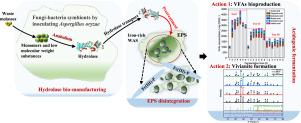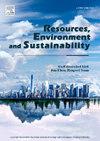A novel hydrolase biomanufacturing-driven strategy for boosting production of volatile fatty acids and vivianite in iron-rich waste activated sludge fermentation
IF 7.8
Q1 ENVIRONMENTAL SCIENCES
引用次数: 0
Abstract
Efficient sludge pretreatment methods that minimize reliance on costly chemical or energy inputs have garnered significant attention, as waste-activated sludge (WAS) disposal occupied nearly 50% of operational expenses in wastewater treatment plants (WWTPs) which displayed a poor sustainability in current practices. In this study, a novel strategy utilizing bio-manufactured hydrolases (primarily protease and -amylase, produced by Aspergillus oryzae based on waste molasses cultivation) was proposed to enhance the solubilization of iron-rich WAS by releasing biodegradable organic matters [a net soluble chemical oxygen demand (COD) of 840 ± 14 mg/L release after 8 h] and disrupting extracellular polymeric substances (EPS) via loosing EPS proteins structure and increase hydrophilicity. The volatile fatty acids (VFAs) production reached a peak level of 4380 ± 24.6 mg COD/L, accompanied by an optimal orthophosphate release of 7.79 ± 0.31 mg/L through fermentation enhanced by such enzymatic pretreatment. Moreover, the relative fraction of P in vivianite, assessed as non-apatite inorganic phosphorous (NAIP), increased by 10.12%. The bio-manufactured hydrolases not only enhanced overall microbial diversity, but also enriched key microbial populations—including hydrolyzing bacteria (e.g. Chloroflexi and Actinobacteria), major acidogens (e.g. Petrimonas, Jeotgalibaca, Proteiniclasticum, and Macellibacteroides), and iron-reducing genera (i.e. Ercella and Desulfovibrio). Furthermore, this strategy upregulated the relative abundance of functional genes related to carbohydrate and amino acid metabolism, and reduced the competitive interference of Ca ions on soluble phosphorus availability by favoring Fe(II)-P complexation, thereby synergistically enhancing VFAs production and vivianite formation. This study presents an efficient, economically favorable pretreatment strategy to enhance the recovery of carbon (C) and phosphorus (P) from iron-rich WAS, with demonstrating a strong application sustainability.

一种新的水解酶生物制造驱动策略在富铁废物活性污泥发酵中促进挥发性脂肪酸和活菌石的生产
有效的污泥预处理方法,最大限度地减少了对昂贵的化学或能源投入的依赖,已经引起了人们的极大关注,因为废物活性污泥(WAS)处理占据了废水处理厂(WWTPs)近50%的运营费用,在目前的实践中表现出较差的可持续性。本研究提出了一种利用生物水解酶(主要是蛋白酶和α-淀粉酶,由米曲霉在废糖蜜培养基础上产生)的新策略,通过释放可生物降解的有机物[8 h后释放840±14 mg/L的净可溶性化学需氧量(COD)]和通过破坏细胞外聚合物(EPS)蛋白结构和增加亲水性来增强富铁was的增溶性。经酶促发酵,挥发性脂肪酸(VFAs)的峰值COD为4380±24.6 mg/L,正磷酸盐的最佳释放量为7.79±0.31 mg/L。磷灰石中磷的相对含量为非磷灰石无机磷(NAIP),增加了10.12%。生物制造的水解酶不仅增强了总体微生物多样性,而且丰富了关键微生物种群,包括水解细菌(如氯氟菌和放线菌)、主要酸化菌(如petronas、Jeotgalibaca、Proteiniclasticum和Macellibacteroides)和铁还原属(如Ercella和Desulfovibrio)。此外,该策略上调了与碳水化合物和氨基酸代谢相关的功能基因的相对丰度,并通过有利于Fe(II)-P络合减少Ca2+离子对可溶性磷有效性的竞争性干扰,从而协同促进VFAs的产生和活菌体的形成。本研究提出了一种高效、经济的预处理策略,可提高富铁WAS中碳(C)和磷(P)的回收率,并具有较强的应用可持续性。
本文章由计算机程序翻译,如有差异,请以英文原文为准。
求助全文
约1分钟内获得全文
求助全文
来源期刊

Resources Environment and Sustainability
Environmental Science-Environmental Science (miscellaneous)
CiteScore
15.10
自引率
0.00%
发文量
41
审稿时长
33 days
 求助内容:
求助内容: 应助结果提醒方式:
应助结果提醒方式:


